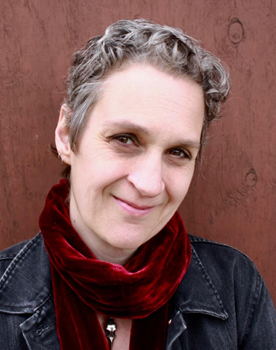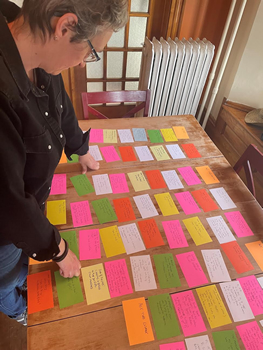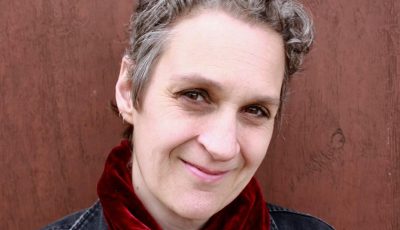

Up Close: Jennifer McMahon
Where Monsters Dwell
Jennifer McMahon’s suspense novels often sidle up to the borders of the horror genre—her 2007 debut, Promise Not to Tell, was a ghost story dressed up as a psychological thriller, and since then she’s written about haunted houses, serial killers, and a knife-wielding murderer in a chicken mask. But THE CHILDREN ON THE HILL is McMahon’s first time tackling one of horror’s favorite elements: monsters and the people who make them.
Like many of McMahon’s novels, THE CHILDREN ON THE HILL unfolds in two separate timelines and concerns childhood traumas that haunt the book’s adult characters. In 1978, Vi and her brother, Eric, live with their grandmother, renowned psychiatrist Helen Hildreth. The kids enjoy a mostly idyllic life, even though the stately old home they share with Gran is across the street from the psychiatric institute Dr. Hildreth runs. Homeschooled and isolated from other children, the kids spend their time rescuing animals, studying science and literature, watching classic horror movies, and hunting monsters in the picturesque Vermont woods around their home.
One day, Vi’s and Eric’s lives are upended when Gran brings home Iris, a girl roughly Vi’s age who doesn’t speak and has no memory of her life before Gran took her in. The kids readily accept Iris as their new sister and initiate her into their monster-hunting club, but when Iris finds her voice and starts asking questions about where she came from, Vi vows to help her unlock the mystery of her past—and the gruesome scar Iris hides beneath a filthy old hunting cap.
Forty years later, the woman now known as Lizzy Shelley—she and Eric have changed their names to distance themselves from what happened to them as children—still spends her days and nights hunting monsters. Lizzy is the host of a podcast called Monsters Among Us, and she’s fresh off a starring role in a monster-hunting reality show that has made her a minor celebrity. She spends most of her time crisscrossing the country in a tricked-out van, following up on reports of cryptids and other legendary figures who haunt America’s forests, swamps, and abandoned places.
But there’s only one monster Lizzy is truly determined to track down: one who lures troubled teenage girls away from their homes, never to be seen again. Lizzy is convinced that her sister is behind the disappearances, and she means to find her and stop her at any cost. As Lizzy draws closer and closer to her target, McMahon fills in her tragic, horrific backstory through flashbacks, excerpts from a true-crime book called The Helping Hand of God, and pages from the monster-hunting manual she and Eric wrote as children.
In her latest interview with The Big Thrill, McMahon talks about finding inspiration in one of horror’s foundational texts, offers some (spoiler-free) insight about constructing her signature plot twists, and teases her next horror-adjacent thriller.
Can you tell me a little about what might have inspired THE CHILDREN ON THE HILL and how the story began to take shape for you?
There’s a lot of me in this book. I grew up in the ’70s, raised by my psychiatrist grandmother. Things were different back then—there weren’t the boundaries and concerns about confidentiality we have now. In addition to her psychiatrist friends, my grandmother’s patients and ex-patients were frequent guests in our home, coming for dinner, weekends, holidays, and summer visits. Like Vi, I idolized my grandmother. I wanted to be a doctor like her when I grew up. She taught me about science and medicine, let me study her medical books, and gave me strange lessons (like teaching me how to make a killing jar for our sick hamsters with chloroform, as Gran does with Vi in the book). Also, like Vi, as I got older, I came to see my grandmother was more complicated than I realized, that she had a dark streak that I’d catch more glimpses of as I grew up.
I also was monster-obsessed as a kid. I loved monster movies and spent a lot of time hunting monsters with my younger brother, making monster traps out in the woods. I was sure they were real, hiding just out of sight.
For a long time, I’ve wanted to put all of this into a book exploring themes of monsters and monstrousness—my childhood with my grandmother, my love of monsters and classic monster movies, and the greatest monster story of all time: Mary Shelley’s Frankenstein.
I’m not a plotter or planner—each book is its own journey, and I began this one with Vi, sitting on her porch, reading Frankenstein. The story grew from there, and I had to keep writing to find out what was going to happen next, if the monsters Vi and her brother so strongly believed in might turn out to be real.
You’ve often talked about writing the books you want to read; for instance, when you wanted to read a ghost story, you wrote Promise Not to Tell, and you’ve called My Tiki Girl the book you wished you’d read when you were 13. Without spoilers, what makes THE CHILDREN ON THE HILL the book you wanted to read?
I wrote this book as an ode to my monster-loving kid self—the girl who was never really sure where she fit in, who felt a little monstrous herself. It’s an exploration of otherness, of questions I’ve been pondering my whole life: What is a monster, why are we so drawn to them, and what might it mean to be one?
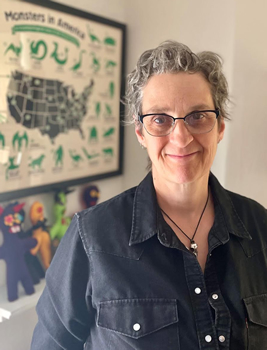
The hunt for cryptids (like the ones on McMahon’s “Monsters in America” poster) plays an important role in THE CHILDREN ON THE HILL.
Besides familiarity, what is it about Vermont that keeps you coming back to it as a setting for your novels?
Vermont is a magical place in so many ways—it’s just so distinctly itself, geographically, politically, culturally. It can feel very idyllic and safe—the quaint villages with a town green and a lovely old church, the beautiful lakes and mountains, the farmers’ markets and apple orchards. What I love to do is take that setting and flip it, showing readers a darker side: places and families that hold secrets, woods and buildings where ghosts and monsters dwell. There’s so much inspiration here: I love to go exploring in the darkest parts of the forest, poking around abandoned buildings, and ghost-hunting in places long rumored to be haunted.
You’re a master of plot twists and truly stunning reveals, and there’s a great one in THE CHILDREN ON THE HILL. Are there any secrets to crafting a plot twist that surprises but still plays fair?
I love a good twist. Sometimes I’ll know right away what it’s going to be, and I kind of build the story around it, like it’s the big middle post holding up a circus tent. This was the case with THE CHILDREN ON THE HILL. Sometimes I have to write the story and wait for the surprise to show itself to me. I think the most important thing is that it has to feel true and make sense in the universe of the story. I think we’ve all read (and maybe even written!) twists that feel like they’re thrown in to unsettle readers, but they just don’t work. It has to be carefully woven into the fabric of the story. Everything has to cleverly lead up to this moment when everything we think we know is turned upside down. If it’s done right, it’s such a rush to read. If it’s done clumsily, we can feel manipulated and tricked.
How do you know if you’ve provided enough clues to set up a twist, but not so many that you tip your hand?
It’s always a delicate balance. Once I know what the twist is and where it will be, I have to make sure I’ve seeded in just a few clues here and there—things that the reader will look back on and go, “Oh! Of course!” but not so many that they’re figuring it out well before the reveal. There’s a lot of trial and error and trusting my gut. I also trust that my readers are clever and astute enough to not need to be hit over the head with things. I heavily rely on showing drafts to early readers to get their feedback. Having a great editor is a huge help, too!
Got any plotting or organizational tricks you can share about juggling multiple timelines and points of view?
I am a huge fan of index cards! Because I don’t plot or plan much before I begin, my rough drafts are a horrible mess. When I’m finished, I print a copy and lay it out on my floor. I color code by timeline and point of view. While it’s there on the floor, I rearrange and restructure, until I feel like the book makes sense and things flow. Then I make an outline with color-coded index cards. I use one card for each scene or chapter. I try to loosely follow the three-act structure, so I make sure I’ve got all the pivotal scenes in the right places (working with two timelines, I’ve got two climaxes at the end of each act!). The colored index cards help me to keep track of it all and make sure I’ve got things happening when and where they’re supposed to be.
Your books often explore formative, intense female friendships. What keeps you coming back to that theme?
It’s what I’m drawn to as a writer and a reader. I think, as writers, we have our obsessions, things that are so deeply ingrained in who we are that they find their way onto the page again and again. Those early formative friendships—the intensity, the secrets—make us who we are, and I love looking back and thinking about how my own friendships and relationships have shaped me. It provides endless fodder, and I think it’s something readers really respond to and can relate to.
It’s easy to see how your background in poetry has influenced your prose. Has it influenced you as a novelist in other ways as well?
Studying poetry taught me a lot about language and metaphor. One of the things I loved doing in my poems was making connections between seemingly random things or events, and I think that’s carried over into my fiction. Starting with a background in poetry also meant I had to work extra hard at plot—it was something that didn’t come easily to me, and I’ve had to really study and push myself to get better at it. Each book teaches me something new.
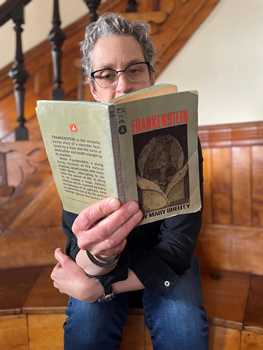
McMahon reads from her much-loved copy of Mary Shelley’s Frankenstein, which helped inspire THE CHILDREN ON THE HILL.
Can you tell us a little about what you’re working on now?
I’m working on a book that’s really freaking me out. People sometimes ask me if there’s something that I’m too scared to write about, and my answer has always been, “Demons!” I’m finally facing my fears and giving it a try. I’m working on a story about a woman who comes to believe her dying mother is actually possessed by a demon. Her family thinks she’s losing it, but she gets more and more sure as the story goes along. Is there really a demon possessing her mother? I don’t know yet (though I have my suspicions). I have to finish the book to find out!
Since you’re both a Vermonter and a cryptid fan, I have to ask: What’s in Lake Champlain?
Champ! Our own Vermont lake monster rumored to resemble the more famous Loch Ness monster. Lake Champlain is huge: 435 square miles of surface water and its deepest point is 400 feet down. A great place for a monster to hide! I look for some sign of Champ every time I’m out by the water. I haven’t spotted him yet, but I’m not giving up.
- Between the Lines: Rita Mae Brown - March 31, 2023
- Between the Lines: Stephen Graham Jones - January 31, 2023
- Between the Lines: Grady Hendrix - December 30, 2022


